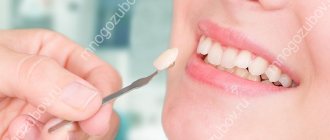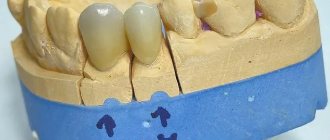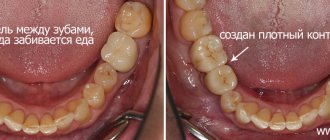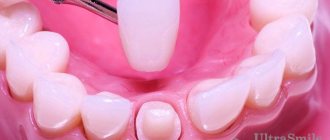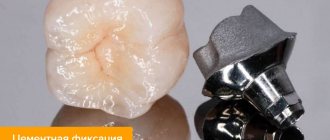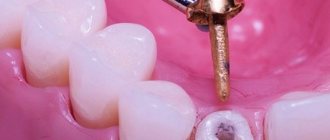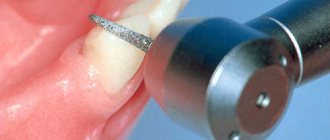- Service life of different types of crowns
- Late crown replacement
- When to change a crown
- How to change crowns
- How often are crowns replaced?
- Additional videos
Sooner or later, most people have to deal with dental prosthetics.
Perhaps the most common type of prosthetics is the so-called “dental crown” (more information about different crowns here). Many patients are their owners, but only a few patients ask questions: do dental crowns need to be replaced, how often should dental crowns be changed, etc.
Let's try to figure it out.
What is the service life of different types of crowns?
As you know, any structure has a certain service life. Unnecessarily long use can lead to dire consequences.
So: how often should crowns be replaced?
It is believed that the average service life of a crown is 5-7 years. At one time, scientists proved that it is after such a period of time that the cement on which the crown is fixed begins to undergo changes. But this does not mean that the crown must be changed every 5 or 7 years. During this period, a doctor should evaluate it to understand whether it can still serve or whether the crown needs to be replaced.
In addition to the duration of use, during a preventive examination, the doctor evaluates the following parameters: the quality of the marginal fit of the crown to the tooth, the condition of the gums and bone tissue next to the crown, X-ray data of the tooth, patient complaints, etc.
When are dental crowns needed?
Dentists have identified the following indications for the installation of this type of prosthesis:
- Destruction of the crown part of the tooth by more than 50%. Most often, this situation occurs with severe caries or with injuries. In this case, a crown is installed to protect the tooth from further destruction.
- Protection of pulpless teeth. Removing a nerve from a dental canal is accompanied by a weakening of the enamel - it becomes fragile, so it is quite advisable to protect it with a crown.
- Any aesthetic defects: tetracycline teeth, fluorosis.
By contacting the AcademyDENT clinic, you are guaranteed to receive a qualified consultation with a doctor who will tell you exactly whether you need a dental crown or whether other treatment methods are possible.
What determines the service life of a crown?
- The service life and the need to replace the structure greatly depend on the accuracy of manufacturing at all stages. Precision work means that the crown fits to the tooth without gaps, without steps, without voids, oral fluid and food do not get under it, the gums around it do not become inflamed, it is no different from the “native” tooth. It is the precision of manufacturing that determines the quality of work, and therefore is the key to a long service life of the crown. For example, I had to deal with a situation where the crown was made only a year ago, and upon examination, strict indications for its urgent replacement were revealed (due to poor quality, namely inaccurate manufacturing). And vice versa, when examined, the crown meets all the requirements, all parameters are normal, there is no need to replace it, and it has been standing for 10 years (which means it was manufactured very accurately and in a timely manner).
- We have repeatedly mentioned that accuracy, and therefore quality, is at the forefront. If we take quality as a given, then the material and method of fixation come to the fore. So, the service life also depends on the material from which the crown is made and, accordingly, on the method of fixing it to the tooth . Classic metal-ceramics and zirconium dioxide-based crowns are attached to a special “cement,” that is, an intermediary between the crown and the tooth, and do not enter into a “chemical” bond with either this cement or the ground tooth. Namely, this cement is “destroyed” and “washed out” over time, leading to a violation of the seal of the entire structure. Crowns based on lithium disilicate (also called “E-max”) are fixed without an intermediary: using the adhesive (“glue”) method, that is, they are glued to the tooth tissue, which leads to a very strong connection between the crown and the tooth. Accordingly, the service life of such structures is longer than the 5-7 years described above, which means that a crown change will not be required soon.
- In addition, the service life is greatly influenced by the condition of the tooth for which the crown was made. If a patient hesitates for a long time to adequately restore a damaged tooth, he comes for prosthetics at an untimely rate, in particular when the tooth is destroyed by a carious process to the level or below the level of the gum, becoming “soft” and unreliable. In such conditions, the doctor is no longer able to make an accurate marginal fit; such a structure will never be completely sealed, which means the tooth under such a crown will be destroyed. In such conditions, neither good materials nor the method of fixing the crown will help. And if the doctor nevertheless undertakes the restoration of such a tooth, this will be the last crown on it, since it will be impossible to repeat the restoration.
Important! Dear patients, do not delay the restoration of damaged teeth, do not deprive yourself of the opportunity to save your own tooth faster, more reliably and cheaper!
By clicking on the “Make an appointment” button, I consent to the processing of my personal data.
I have read and agree with the conditions for processing personal data set out on the website ds-chocolate.ru.
Consent to the processing of personal data
Preparing for installation
A crown cannot be placed on an unprepared tooth. He must be completely healthy. If you have inflammatory diseases of the oral cavity, they need to be cured before installing a crown.
Then the teeth are ground down. It is performed under anesthesia, so the patient does not experience any discomfort. This procedure is carried out to ensure that the denture fits perfectly and no food remains get stuck under it. It also allows you to equalize the width of the neck and middle of the tooth. This way the prosthesis will be firmly fixed, which will prevent loosening.
Only 1-2 mm of enamel is removed. The depth of treatment depends on the selected crown material: metal-ceramics require more space, and ceramics are quite thin; a very thin layer is removed to install it.
In some cases, depulpation is performed. The patient is warned about its need in advance.
If the tooth is severely damaged, a core inlay is installed. It separates the internal tissues from the crown, allowing you to avoid pain while wearing it.
Upon completion of all manipulations, a temporary crown is installed on the tooth. It is made in the dentist's chair. The design protects the prepared area and restores its aesthetic appearance.
What are the consequences of untimely crown replacement?
1. Destruction of the tooth under the crown with its subsequent loss.
The main function of a crown is to restore a badly damaged tooth and protect it. The first time after installation, the crown performs its function perfectly. But after a certain time, changes occur. The gingival margin rises, saliva and gingival fluid affect the cement that “secures” the crown. Over time, this cement can be partially washed out (dissolved), a microscopic gap is formed between the crown and the tooth, and the tooth begins to deteriorate under the influence of microbes and oral fluid. The most insidious thing is that these signs occur asymptomatically and unnoticed by the patient, since they are painless. Therefore, replacement of crowns often occurs untimely, when the tooth is destroyed too much and becomes simply unreliable.
Associated with this is the myth that teeth under crowns are destroyed. The truth is that crowns are simply replaced at the wrong time, but too late.
This can be prevented by timely replacement of the orthopedic structure.
2. Inflammation of the tissues around the crown . This means the gums, tooth ligament and bone tissue. A poor-quality crown can lead to the formation of a chronic inflammatory process in the gums (gingivitis, periodontitis), which is manifested by redness, bleeding when brushing teeth, aching pain in the gums and an unpleasant odor. If such a crown is not replaced for a long time, the underlying tissues become involved in the inflammatory process, which may lead to the formation of bone pockets, disruption of the ligamentous apparatus of the tooth, and local periodontitis, which in severe cases leads to tooth loss.
Photo 2.1. Inflammation of the gums near teeth under crowns, associated with inaccurate marginal fit of the crown to the tooth and with a violation of the biological parameters of tooth restoration.
Important! Make it a rule to visit the dentist for a preventive examination at least once a year, if you have any dentures, in order to notice their failure in time and prevent or correct the problem.
The problem with old crowns that are 10 – 20 years old or more
Many people have old orthopedic structures in their mouths: bridges, crowns.
They can be metal or combined plastic. Patients come to us who have been wearing these crowns for 20 years or more. And then there comes a time when a person is no longer satisfied with the old crowns.
- Old crowns are not functionally satisfactory, since they can no longer chew food normally, because they have already eaten, sometimes even worn down to holes.
- Old crowns are not aesthetically pleasing
, as they are worn out, blackened, grayed, and chipped.
How do you know if it’s time to change the crown or if it can still serve?
There are objective signs that reflect the condition of crowns/bridges, which are assessed by an orthopedic dentist during a routine examination:
- service life of the crown/prosthesis
- patient complaints (pain, food getting stuck near the crown, unpleasant odor near the crown, and others)
- fit of the crown to the tooth (marginal fit)
- the presence of areas of plaque accumulation
- condition of the gums next to the crown (color, bleeding, density, presence of other signs of inflammation, raising the edge of the gums (exposure of the root))
- presence of signs of inflammation of the bone tissue around the tooth with a crown
- density of interdental contact (crowns with adjacent teeth).
If one or a number of signs are present, the doctor decides whether the crown needs to be replaced.
Dental crowns in our clinic
Specialists from the Beryozka clinic will help you place strong dental crowns based on an individual impression. Our doctors work according to the most modern treatment protocols, which ensures maximum similarity of the artificial crown with the real one. High-tech materials ensure long-lasting wear even with intensive use of the crown.
Making a crown based on an individual impression ensures the most comfortable use. And budget prices allow you to restore the beauty and functionality of the jaws to a person with any income.
Free consultation!
You can get acquainted with the specialists of the Beryozka clinic and decide on the need to install a crown at a free consultation. Our doctors are confident that the patient, once in their hands, will definitely return for treatment. This is facilitated by the beautiful and comfortable environment in the offices, friendly and polite staff, as well as the high professionalism of the dentists.
Can the patient himself understand that it is time to replace the crown?
Certainly! There are a number of signs, the presence of which should give cause for concern.
- The most common is crown edge exposure , when the gingival margin rises and the tooth root becomes visible (“gingival recession”). In this case, root caries may develop, that is, the tooth may be destroyed.
Photo 2.2. The initial stage of exposure of the roots of the teeth under the crowns.
Photo 2.3. The advanced stage of exposure of the roots of the teeth under the crowns.
- Inflammation of the gums around the crown , which manifests itself in redness of the gums, swelling, and bleeding when brushing.
Photo 2.4. Inflammation of the gingival margin of teeth under crowns, associated with inaccurate marginal fit of the crown to the tooth and with a violation of the biological parameters of tooth restoration.
- The appearance of crown mobility . Patients often say that the crown or bridge is “fixed.” This happens especially often when several crowns are combined (some of the crowns of the bridge have become uncemented, while the rest are still holding together).
- The appearance of an unpleasant odor or taste in the crown area.
- Food getting stuck between crown/crown and tooth.
Important! All of the above signs are a mandatory reason to visit the dentist.
What experts recommend
To avoid complications and install a high-quality, durable prosthesis, you need to contact an experienced orthopedist who will conduct a full examination before prosthetics and model an anatomically correct design. It is also important that the support is properly prepared - the canals are thoroughly cleaned and sealed, the upper part is sharpened, and a suitable implant is selected. To restore teeth, today they offer several methods for making crowns, and the optimal one is milling using CAD/CAM technology. This results in very tight-fitting structures, under which germs and food particles do not penetrate, so they last longer than others.
How are crowns replaced?
A separate article will be devoted to this. Let us briefly describe the main stages:
Stage 1 : examination by a doctor and diagnosis (X-rays). We evaluate the accuracy of the crown fit, the condition of the tooth and surrounding tissues. We understand that the crown needs to be replaced.
2nd stage : silicone key (necessary for the doctor to make you a temporary crown so that you do not go without a tooth after removing the old one)
Stage 3 : we evaluate the tooth under the crown, give it the correct shape, clean it, and remove possible caries. We fix the temporary crown. You can't go a day without a tooth!
Stage 4 : we take impressions for the new crown and send them to the dental laboratory.
Stage 5 : we get a new crown, fix it on the tooth and happily say goodbye to the doctor until the next professional examination.
Where to replace a crown with high quality in Kharkov?
In “Harmony” dentistry, we install metal-ceramic and metal-free (ceramic) crowns on teeth . Our specialists will qualitatively restore your teeth and take care of the long-term results of prosthetics. You can receive a consultation and examination to determine if your orthotic needs replacement. After installing or replacing crowns , you will be able to regularly visit your doctor and resolve any issues in a timely manner. Modern materials and equipment and highly qualified doctors of the Harmony clinic in Kharkov will help maintain health and a beautiful smile for a long time.
Bottom line: how long does it take to replace crowns?
According to the book rules : in 5-7 years.
It is better to replace poorly made crowns immediately after placement, so that the teeth underneath do not deteriorate.
Well-made crowns can last 10 years or more.
Conclusion: any crown has a certain service life, which depends on the characteristics of the clinical situation (tooth condition), quality of workmanship, material and method of fixation. The need for replacement is determined by the doctor based on a number of objective factors. Timely replacement allows you to reuse the same foundation (tooth, root) to repeat the structure. Accordingly, the tooth will last for many years. Untimely replacement of the crown (unreasonably long use) can lead to deep tooth destruction, which will be impossible to restore.
An attentive attitude to one’s health on the part of the patient, coupled with timely and qualified assistance from a doctor, leads to a long-term positive result.
By clicking on the “Make an appointment” button, I consent to the processing of my personal data.
I have read and agree with the conditions for processing personal data set out on the website ds-chocolate.ru.
Consent to the processing of personal data
Be healthy!
Kirill Andronov on how often you need to change crowns
Pros and cons of crowns
All medical procedures have both pros and cons. Before you decide to install crowns, you should compare the pros and cons.
Advantages
The advantages of using this method of prosthetics are much greater than the disadvantages. The advantages of installing crowns include:
- preventing the destruction of pulpless teeth;
- preservation of a living tooth even with partial destruction;
- restoration of the ability to chew food normally;
- restoration of an aesthetic appearance while smiling;
- prevention of diseases of the gastrointestinal tract, which can be caused by insufficient chewing of food;
- restoration of the ability to speak clearly.
Due to the large number of advantages, the procedure has become so popular among patients.
Flaws
The procedure for installing crowns has its disadvantages. Flaws:
- the need to grind healthy parts of the tooth;
- limited period of wearing a prosthesis;
- inability to carry out the procedure with a damaged root;
- the need for regular visits to the dentist for monitoring.
The disadvantages of the procedure are offset by its advantages. Therefore, crowns remain the most popular way to restore the integrity of the dentition.
Plastic dental crowns
Dental crowns made from plastic are the cheapest option of all types of dental crowns. They are made the fastest and easiest, the cost of material for them is the lowest. Most often, temporary crowns are made from plastic and placed on patients while permanent crowns are made from a different material.
Pros:
- fast production;
- ease of installation;
- cheapness.
Flaws:
- wear out quickly - service life does not exceed 2 years;
- low strength - it is not recommended to install them on chewing teeth;
- low aesthetic value.
Self extraction
Self-extraction is not recommended. Using tools that are not intended for this purpose (pliers or wire cutters) can lead to injury to the mucous membranes and breakage of the tooth stump.
But there are cases when the microprosthesis has completely separated from the tooth and is loose, or even broken into pieces, which creates a danger of swallowing it along with food. In this case, you need to remove it and visit a doctor as soon as possible to install a new microprosthesis.
In the video, the dentist will tell you what harm old crowns cause to your health.
How much does it cost to fix crooked teeth?
If you want to know what to do about crooked teeth, the first step is to consult a qualified orthodontist. He will determine which method is best to use and install a corrective system.
Modern dentistry offers a wide range of systems for correcting crooked teeth and malocclusion. They all vary in cost. It is important to choose not only a correction method that is suitable for the price, but also to contact qualified specialists.
There are not so many orthodontists with the required qualifications (as well as dentists of other specializations), but at the 32 Dent clinic there are specialists who install braces, veneers and other bite correction systems for adults and children. It’s also nice that the clinic has fairly affordable prices, so almost all patients can correct their crooked teeth.
Procedure for re-prosthetics
Replacement is carried out in several stages. Specific actions are determined by the condition of the supporting tooth, the material and design of the microprosthesis.
In general, the sequence of work looks like this:
- Examination of the oral cavity, making a decision on replacing a microprosthesis, choosing its type.
- Removing the crown.
- X-ray.
- Treatment of the abutment tooth (if necessary).
- Preparation (turning).
- Taking an impression from the supporting tooth and its antagonists.
- Manufacturing and installation of a provisional prosthesis (if necessary).
- Making a new design.
- Fixing it on the tooth.
Below are some features of replacing crowns of three main types - conventional, post and implant.
Crown on a tooth
Before you do anything with the tooth, you need to remove the old structure.
Removal
There are two options for removal - with the destruction of the microprosthesis and maintaining its integrity. If the condition of the product is unsatisfactory (extreme wear, cracks, chips), there is no need to keep it intact. In this case, it is simply cut with an abrasive wheel and removed with forceps.
They try to remove unworn or expensive zirconium structures without destruction for the purpose of subsequent installation. There are different types of non-destructive removal tools. The Kopp crown remover is most often used.
The principle of its operation is based on the generation of a shock impulse that moves the crown relative to the tooth. Usually, the bonding cement is first destroyed by ultrasound, then the microprosthesis is removed. The patient feels quite noticeable shocks. If the tooth is sensitive, local anesthesia is performed.
Removing an all-ceramic structure without destruction is a difficult task, so such products are usually made anew.
Dental treatment
Treatment is carried out taking into account the condition of the tooth that led to the need to replace the crown. This can be depulpation, resection of the root apex, cyst removal, removal of dental plaque, antiseptic treatment, antibiotic therapy.
After treatment is completed, the tooth is restored with a composite or inlay and ground down for a crown.
Prosthetics
The work on manufacturing and installing a new microprosthesis is no different from primary prosthetics. Impressions are made of the supporting tooth and its antagonists, plaster models are cast from them, on the basis of which crowns of the selected type are made.
On the pin
Dentures on pins are usually installed when there is significant or complete destruction of tooth dentin. In this case, different pin designs are used: parapulpal (for vital pulp), intracanal (for pulpless teeth), pins cast integrally with the microprosthesis. The material used for the pins is metal or carbon.
The technology of re-prosthetics depends on the chosen design. If the prosthesis is disconnected at the point of contact between the pin and the stump of the tooth, a new stump is restored on the pin and a crown is installed on it.
When a pin falls out of the root canal, it is prepared for installation of a new pin. The most difficult case is a broken metal rod at the level of the canal mouth. In this case, it may be necessary to remove the tooth and install a bridge or implant.
On an implant
In microprosthetics on implants, the tooth stump together with the crown is attached to the abutment using a screw (detachable connection) or cement (one-piece connection).
The most common reason for removing a crown from an implant is the need to treat peri-implantitis , an inflammatory and necrotic process at the site of contact between the implant and the bone.
The main goal of all treatment measures in this case is to avoid rejection of the artificial root. The process of installing a microprosthesis on an implant is simple and does not cause any difficulties.
Reviews
If you had to change crowns, please share your impressions of this procedure. What type of microprosthesis was it, how many years did it serve, was the old structure installed or a new one, how was it removed? You can leave your comment using the form located at the bottom of this page.
If you find an error, please select a piece of text and press Ctrl+Enter.
Tags dental crowns fixed prosthetics
Did you like the article? stay tuned
Previous article
Etiology of retrognathia and its progressive treatment
Next article
Design features and methods of implantation of screw implants
Possible complications
The recommendation to consult a doctor promptly for any health problems is a hackneyed platitude. But in this case it is impossible to avoid it.
Destructive processes in a tooth covered with a crown occur initially unnoticed and painlessly for its owner. But sooner or later symptoms appear that should alert him and prompt him to see a doctor.
It is important to understand that if a pathological process has begun under the denture, it will not stop on its own, and if left untreated, it will inevitably lead to tooth loss.
How quickly a person goes to the dentist, feeling that there is a problem with his crown, determines whether he will save the tooth or not, and how much time and money he will spend on treating it or replacing it with a prosthesis.
Delay in seeing a doctor can lead to the following consequences:
- Complete destruction of dentin under the microprosthesis due to the carious process.
- Development of apical periodontitis , as a result of which serious treatment may be required - resection of the root apex, refilling of canals, removal of cysts and granulomas.
- Atrophy of the bone tissue surrounding the tooth. Correcting this will require bone grafting and a long healing period.
- Fracture of the root of the abutment tooth. Will lead to the need to remove it.
- Abrasion of the occlusal surface of the prosthesis up to its perforation. Through the resulting hole, pieces of food will enter and rot, causing a foul odor, destruction of dentin and the transition of the destructive process to the roots.
- Pathological changes in the ligamentous apparatus of the supporting tooth (periodontium). The tooth will begin to loosen. Depending on the severity of the pathology, it will have to be splinted or removed.
Delay in replacing or repairing crowns on implants is especially dangerous, as this can lead to peri-implantitis and rejection of the artificial root and, as a consequence, to serious and lengthy treatment.
In what cases is it justified to fix combined crowns and their service life?
Come here to take a closer look at modern types of metal-free crowns.
At this address https://www.vash-dentist.ru/protezirovanie/nesemnyie-p/koronki-np/metallicheskuyu-s-napyileniem.html read what spraying is done on metal crowns.
Price issue
The cost of replacing a crown consists of the cost of two operations - removing the old structure and installing a new one. In most cases, removing an old microprosthesis is inexpensive - does not exceed 1,000 rubles.
An exception may be an expensive zirconium structure while maintaining its integrity. In this case, it is necessary to use a special tool, and the withdrawal price can rise to several thousand.
The cost of installing a new design does not differ from that of the first prosthetics. It depends on the material of the microprosthesis and the design (partial, complete, metal-free, combined, pin).
When planning the cost of replacing a crown, you can focus on the following prices:
- all-plastic (temporary) – up to 1,000 rubles;
- metal-plastic - from 2,500 rubles;
- all-ceramic – from 10,000 rubles;
- metal-ceramic - from 8,000 rubles;
- zirconium dioxide – from 15,000 rub.
In reality, these prices can change in any direction depending on the company producing the material, location and status of the clinic.

